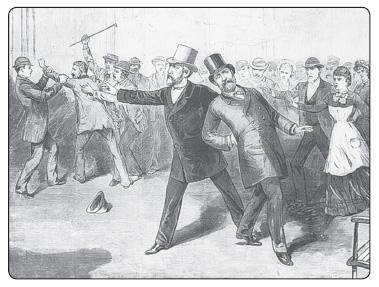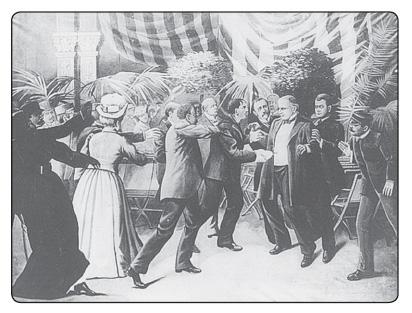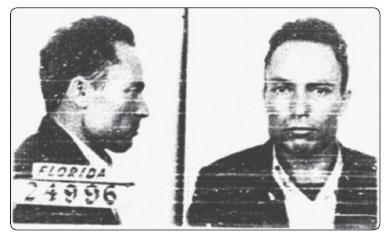History Buff's Guide to the Presidents (34 page)
Read History Buff's Guide to the Presidents Online
Authors: Thomas R. Flagel
Tags: #Biographies & Memoirs, #Historical, #United States, #Leaders & Notable People, #Presidents & Heads of State, #U.S. Presidents, #History, #Americas, #Historical Study & Educational Resources, #Reference, #Politics & Social Sciences, #Politics & Government, #Political Science, #History & Theory, #Executive Branch, #Encyclopedias & Subject Guides, #Historical Study, #Federal Government

The Presidential Box at Ford’s Theatre was photographed shortly after the shooting of Lincoln. Note that the bunting to the right hangs lower, where assassin John Wilkes Booth caught his spur during his leap to the stage and ensuing escape.
Taken to a boardinghouse adjacent to the theater, the president died in nine hours. Though Lincoln would never gaze upon another face, he had seen his killer on stage before, in an 1863 production called
The Marble Heart
.
Sadly, the tragedy was not yet done. Rathbone survived his wound and eventually married Clara Harris, only to stab her to death years later. He was committed to an insane asylum, where he died. Mary would enter an asylum as well, soon after the death of her eighteen-year-old son Tad in 1871. Mentally shattered, she was sentenced in large part because of the testimony of her only surviving child, Robert, who stated under oath, “I have no doubt my mother is insane.”
136
Robert Todd Lincoln would go on to serve as James Garfield’s secretary of war and be present at his shooting in 1881. In 1901, Robert was on his way to see President William McKinley when that president was gunned down. In 1928, his remains were laid to rest in Arlington Cemetery, near the future burial plot of John F. Kennedy.
3
. JAMES A. GARFIELD (JULY 2, 1881)
By the audacity of the act, anyone who tries to murder a president is often assumed to be insane. More than likely, the assumption was correct with thirty-nine-year-old Charles Guiteau. He was of unstable lineage. At least two cousins and an uncle perished in mental asylums. His abusive father claimed to be immortal. Himself a hyperactive but cerebrally slow child, Guiteau attained four things in adulthood: a dubious law degree, religious fanaticism, an incurable case of syphilis, and the belief that he would one day be president.
137

James Garfield is shot twice from behind by the delusional Charles Guiteau. The president initially believed he would die within minutes. Instead, he lingered for eighty days before succumbing to massive infection.
His lofty aspirations seemed tangible after the elections of 1880. Guiteau had written a flavorless, wandering speech endorsing Republican candidate James Garfield. He mailed it to the nominee, passed out copies to strangers, and may have once or twice delivered the drowsy lecture to small audiences. When Garfield won, Guiteau believed his little writing caused the outcome, and he expected to be compensated.
138
Throughout the spring of 1881, he wrote letters, grilled party officials, and pestered White House staff. No one would listen to him. Convinced that Garfield would know who he was, he lined up with other office seekers, met the president in person, and demanded an ambassadorship. When Garfield abruptly rejected him, Guiteau left and bought a .44 snub-nosed revolver. For weeks he stalked Garfield around Washington, waiting for the right moment, reassuring himself that Garfield would be “happier in Paradise.”
139
On July 1, at the Baltimore and Potomac Rail Station, just as the president, his family, and his staff prepared to depart the capital for a summer respite, Guiteau approached the entourage from behind and fired. He stepped closer and fired again, just as nearby police and officials subdued him.
Hit in the arm and lower back, Garfield started to vomit profusely. Between gasps for air, the president calmly assessed the situation—“I am a dead man.”
140
Garfield would never walk again. For eighty days he withered in his White House bed, rallying on occasion and quietly enduring ordered isolation. Though medical schools were beginning to grasp the concept of germ theory, a myriad of doctors repeatedly probed for the bullet using gloveless fingers and unwashed instruments, sometimes reaching a depth of twelve inches with their repetitious, forceful jabs.
141
After a transfer to New Jersey, where Garfield sought the calming effects of the coastline, infections accelerated. He succumbed two weeks later, in severe pain, at the age of forty-nine. Weeks later, Guiteau was convicted of murder and sentenced to hang. He would be executed almost a year to the day, and quite near the location, of his crime.
Charles Guiteau purchased an expensive, ornate revolver for the shooting, assuming that it would be prominently displayed in a museum one day. The weapon has since been lost.
4
. WILLIAM McKINLEY (SEPTEMBER 6, 1901)
The “progress” of the Industrial Revolution brought newfound miseries for the working poor—tepid slums, morbid factories, child labor, and eighty-hour workweeks. Beneath the new shadows of high-rises coagulated a bog of abject poverty. This growing divide between rich and poor spawned a widespread anarchist movement enunciated by eloquent idealists and punctuated by the destitute. The goal was a world without politicians. The means was assassination.

President McKinley takes a bullet in the stomach from point-blank range. Ever tender-hearted, the severely wounded McKinley first thought of his ailing wife. He then ordered his guards not to hurt the man who had just shot him.
In 1894, an anarchist fatally stabbed the president of France. In 1897, another anarchist shot and killed Spain’s premier from point-blank range. In Geneva, a jobless man, so poor that he could not afford to buy a knife, fashioned a homemade dagger and drove it into the heart of the empress of Austria. Two years later, an assassin gunned down King Humbert of Italy.
142
News of King Humbert’s murder aroused the imagination of Polish American Leon Czolgosz, a twenty-eight-year-old unemployed factory worker who had recently experienced a caustic, mood-altering illness. Deeply troubled by American military involvement in the Philippines and the continuous specter of strikes, evictions, and poverty in his adopted country, the young man resolved to kill whom he later called “the enemy of the good working people.”
143
In early September 1901, Czolgosz traveled to the Pan American Exhibition in Buffalo, New York, to confront William McKinley. The president’s security detail at the conference included three Secret Service operatives, four Buffalo municipal detectives, eleven members of the U.S. military, and eighteen policemen.
On the afternoon of September 6, after addressing a crowd of thousands on the benefits of international cooperation, McKinley received the general public as people filed through the exhibition’s Temple of Music. Standing in line was Czolgosz, his right hand heavily wrapped in a white handkerchief concealing a revolver. As McKinley extended his arm to greet him, Czolgosz blasted two shots into the president’s midsection. Assuming he had been fatally wounded, McKinley pleaded to his aides: “My wife. Be careful how you tell her.”
144
Hours later an operation failed to find the bullet, yet the patient emerged relatively free from pain. Days of steady improvement offered hope, until Friday, September 13, when a high fever and acute weakness signaled the onset of gangrene. Early the next morning, McKinley quietly passed away. Six weeks later, having admitted guilt at an abrupt trial, Czolgosz died in the electric chair at New York’s Auburn Prison.
Newly promoted Theodore Roosevelt, in his first presidential message to Congress, demanded a halt to all immigrants who were extremely poor and/or illiterate. For the country to survive the wave of terror that claimed McKinley’s life, Roosevelt argued, it had to “decrease the sum of ignorance…out of which anarchistic sentiment inevitably springs.”
145
To prevent admiring anarchists from stealing the assassin’s body, prison officials filled Leon Czolgosz’s coffin with quicklime and sulfuric acid.
5
. FRANKLIN DELANO ROOSEVELT (FEBRUARY 15, 1933)
President-elect Franklin Roosevelt came to Miami with a landslide victory behind him and troubles innumerable ahead. The already catastrophic Depression appeared to be worsening. Bank failures and property foreclosures continued unabated. World grain production, the foundation of nearly every national economy, had declined by a fourth. Joblessness neared 25 percent in the United States, Japan, and Britain, more than 30 percent in France, and almost 50 percent in Eastern Europe. Representative governments were falling everywhere. Two weeks before Roosevelt traveled to Florida, a xenophobic militarist declared himself dictator in Germany.
146
Arriving in Miami after a long fishing trip on the Astor family yacht, FDR offered a few words of encouragement to a host of twenty thousand citizens gathered at Bay Front Park. In attendance was Chicago Mayor Anton Cermak, looking to secure the good graces of his party’s ascending chief. After FDR spoke from atop the backseat of a stretch convertible, Cermak approached to shake his hand. As the two men spoke, rapid gunfire rang about them, emanating from the store-bought pistol of Giuseppe Zangara, standing just ten yards away.

Giuseppe Zangara, an unemployed Italian immigrant, allegedly had a newspaper clipping of the McKinley assassination in his pocket when he attempted to murder Franklin Roosevelt.
State Of Florida Archives
Zangara hit five people with five shots, none of whom were Roosevelt. Clearly the most seriously injured was Cermak, and before the convertible could speed away to safety, Roosevelt demanded the mayor be placed in the car and driven to the nearest hospital.
Upon hearing the assailant was an unemployed bricklayer from Italy, FDR hypothesized that the attack was a mafia hit on Cermak. No such mob connection materialized. Yet Zangara officially became a murderer when the Chicago mayor died from his wounds three weeks later, just two days after FDR’s inaugural promise of “the only thing we have to fear is fear itself—nameless, unreasoning, unjustified terror.”
147
By the end of the month, Zangara was dead as well, electrocuted by the state of Florida. He proclaimed to the end, in broken English, to hate the wealthy, the elite, and all presidents.
Though outwardly optimistic about the nation as a whole, FDR viewed his own chances of survival with pragmatic fatalism. He refused any additional security after the shooting, and no one recollected his ever mentioning the incident in Miami ever again.
148
One of the first officials to question Giuseppe Zangara was Roosevelt adviser Raymond Foley, who as a child in 1901 stood very close to William McKinley at the time of the fatal shooting.
6
. HARRY S. TRUMAN (NOVEMBER 1, 1950)